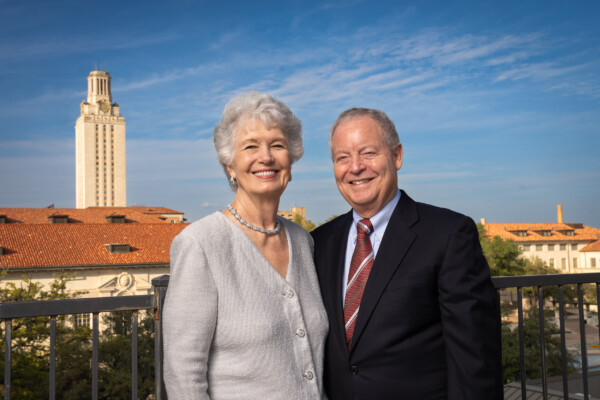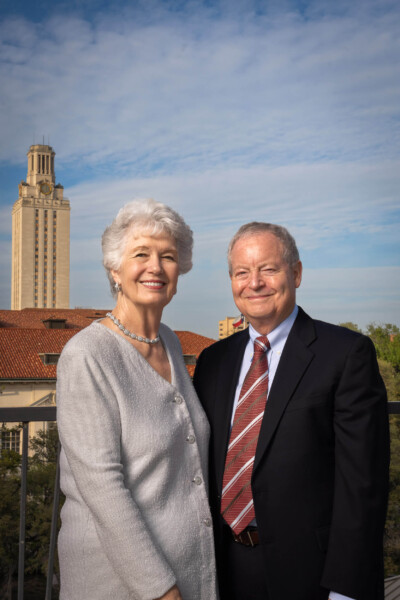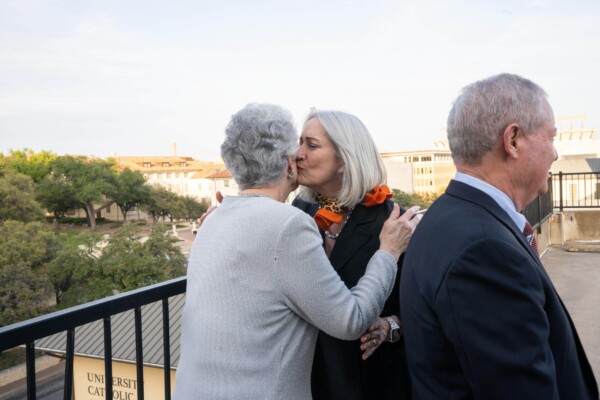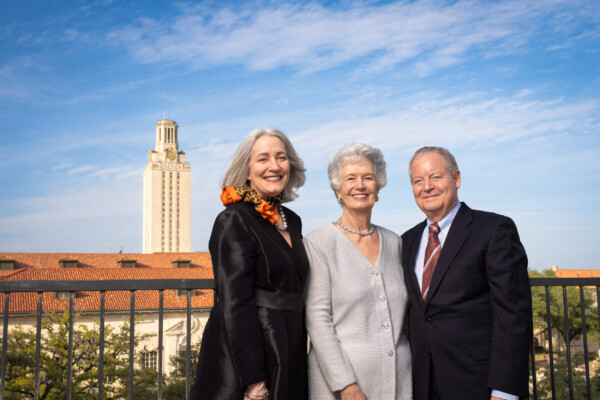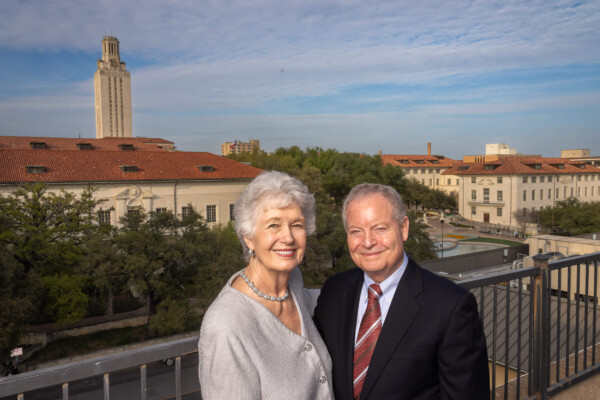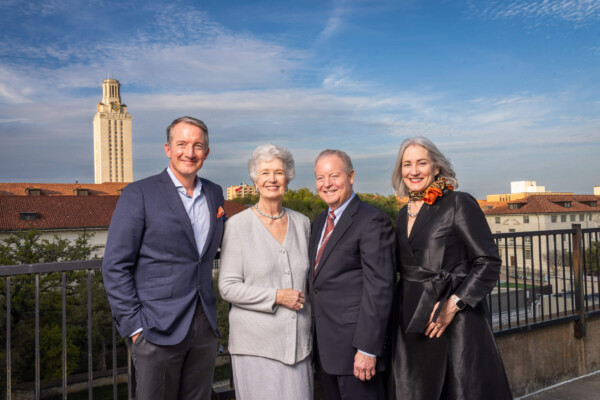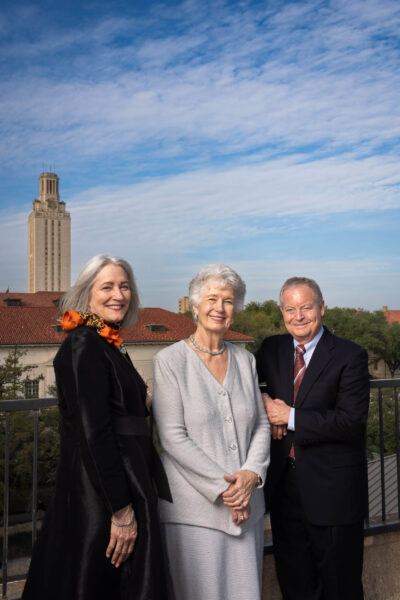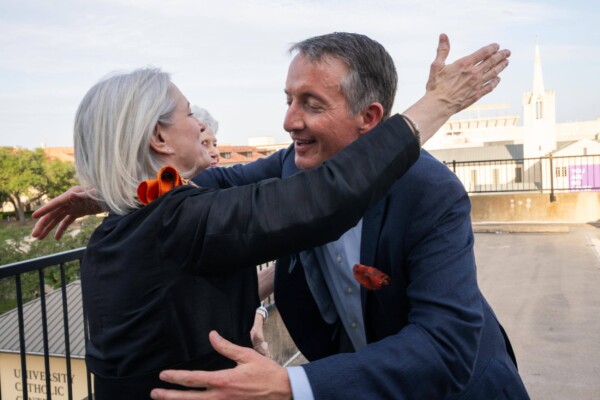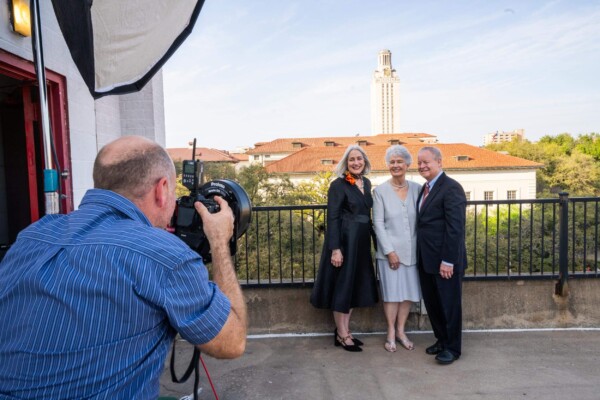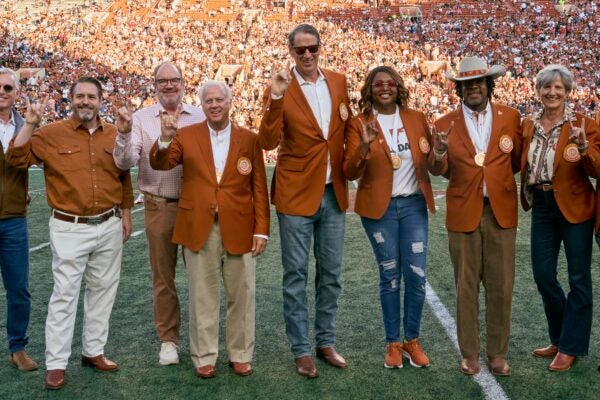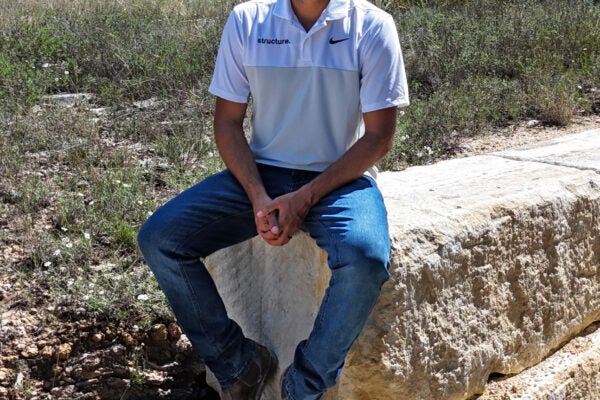A Vision
With A View
Making A Statement With Mulva Hall, A New Undergraduate Building That Casts An Unblinking Gaze On The Future
by Judie Kinonen | photos by Jeff Wilson | renderings by Perkins&Will
After the dimly lit, zigzagging ride to the top of Dobie Parking Garage, Miriam and Jim Mulva, BBA ’68, MBA ’69, stepped out of the car on a recent spring day with McCombs Dean Lillian Mills, all three squinting in the late-afternoon Austin sun.
It was a unique setting for a magazine photo shoot: a deserted garage slated for demolition. But as the Mulvas and Mills greeted the photographer and followed the camera’s line of sight to the northeastern horizon, their faces softened into broad smiles.
They gazed north toward the UT Tower, then east, past a patchwork of burnt-orange tiled roofs toward Darrell K Royal-Texas Memorial Stadium. When UT President Jay Hartzell joined them, he too became absorbed. Peering down, they watched students stroll along the sunny South Mall. Littlefield Fountain spouted crystal blue. “It’s the classic UT view,” Mills said.

But this remarkable view from six stories high is a poor preview of the one coming. When a new undergraduate business school building named for the couple — Mulva Hall — rises on this very site, it will stand 17 stories and provide a sweeping vista of the Forty Acres. The $425 million building opens to students in Fall 2028, and it will be one of the tallest academic buildings on campus, standing as a landmark among landmarks with views of the Capitol, the Tower, and the University’s original 40 acres.
For the Mulvas and a group of fellow visionaries, that view will have been more than a decade in the making. Initially seen as a renovation in 2011, the vision began to change with the Mulvas’ gift of $40 million in 2014. The UT System Board of Regents approved funding the new building in November 2023, $50 million from McCombs reserves, $150 million in philanthropy, and $225 million with financing from the UT System. Now, Dobie Garage is set for demolition this summer, and pending final Board of Regents approval in November, ground will break this year for this state-of-the-art educational complex.
Sited with expansive plazas off University and Whitis avenues, the 373,000-square-foot Mulva Hall will hold flexible, multipurpose event spaces and 29 classrooms, including a collaborative learning auditorium with room for 200 people and three specialty educational labs with enhanced technology for experiential learning. The dean’s office suite will anchor a slender tower that houses the school’s academic departments and faculty offices.
Standing on the site, the Mulvas eye the culmination of their decision to give back to an institution near to their family’s heart and, ultimately, to inspire unprecedented generosity. Months before the foundation is laid, Mulva Hall has already made history: It’s on track to be a donor-led UT building project with the largest total philanthropic sum ever raised.
‘A COMPETITIVE SPORT’
The Mulvas are Wisconsin natives with deep UT roots. Jim was a transfer student on a Navy ROTC scholarship, determined to marry and earn an MBA from UT before deployment. He completed the two-year master’s program in just one year.
“All I did was study,” he says, chuckling.
That innate discipline paid off. After completing his service to the U.S. Navy in 1973, he started as a financial management trainee with Phillips Petroleum, ascending to chief financial officer, president, and chief executive officer of ConocoPhillips after the two energy companies merged. He retired in 2012.
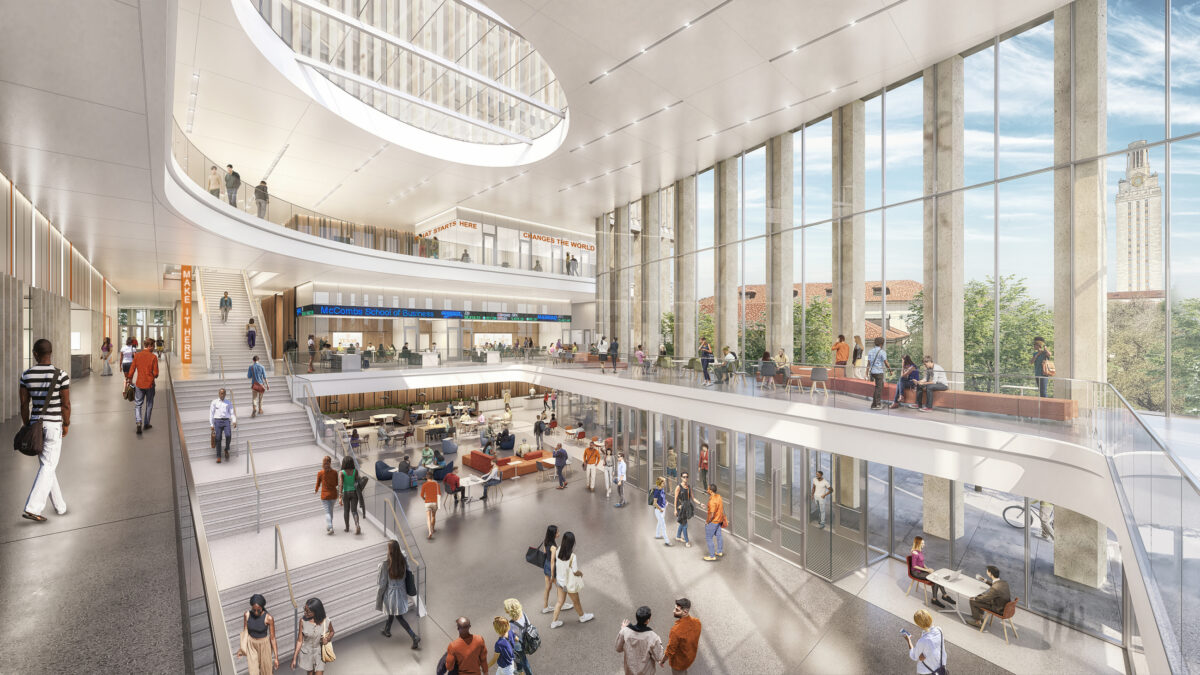
Miriam has been active in local initiatives related to the Catholic Church, community, and the arts. She was a regular volunteer and presence at swimming competitions with their sons, Stephen and Jonathan.
Inspired by their Catholic faith, the Mulvas have a long history of giving. Their donations to UT’s Dell Medical School, Cockrell School of Engineering, and ROTC in the College of Liberal Arts, as well as their support of the University Catholic Center, have immeasurably enhanced UT’s campus, programs, and student life.
MIRIAM AND JAMES J.
MULVA HALL:
FACTS, FIGURES, AND FIRSTS
specialty classrooms
auditorium
size
The business school was not actively soliciting the Mulvas when, in 2014, they decided to divide a $60 million gift to support building campaigns — $20 million to UT’s engineering school and $40 million to the business school.
Their vision was to refurbish the College of Business Administration/Graduate School of Business (CBA/GSB) buildings, which opened a half-century ago to house undergraduate business faculty offices and classrooms, among other campus operations.
In talks with then-Dean Jay Hartzell, a new vision took shape: Rather than refurbish the existing complex, the Mulvas’ gift would be used to create a new, state-of-the-art undergraduate facility on the southwest corner of campus. That would create for McCombs a complete “business neighborhood” — pillared by the AT&T Hotel and Conference Center, Rowling Hall, and the new Mulva Hall.
“This munificent gift set off a transformative chain reaction among McCombs’ friends,” says Mills, who inherited the project when she took on the dean’s role in 2020. “Through their generosity, the Mulvas shifted the school’s aspirations for generations to come.”
Early donor Ray Nixon, B.A. ’74, MBA ’77, chair of Nixon Capital and a long-time McCombs benefactor, agrees. “Philanthropy in Texas is a competitive sport,” he says. “We all love to be part of the same team, and when we know that other donors we respect have already done the due diligence, it’s easy to come alongside.”
Along with Nixon, Mindy Hildebrand, BBA ’86, Gary Crum, MBA ’72, and Aaron Kozmetsky, MBA ’95 (on behalf of the Kozmetsky Family Foundation), and many other early investors each pledged more than $1 million before anyone knew the project’s full scope. Soon, $80 million was committed.
“The theme of those early conversations with donors was ‘investment,’” says Hartzell. “These are consummate business leaders, and they immediately understood this project as an investment in the people who would execute on a bold future for the industries they’ve helped to build.”
Hildebrand and her husband, Jeff, were early believers in the vision for a new undergraduate building and have hosted groups of prospective early investors to their home in Houston.
Hildebrand, who along with Ray Nixon is a co-chair of the McCombs Campaign Committee, highlighted the good fortune of having a UT president who also received a degree from McCombs understanding early on the needs of the school. “The existing building was appropriate in the ’80s when I was a student,” she says, “but teaching styles have evolved, requiring different special conditions for optimal learning. Jeff and I were happy to be one of the first investors in Mulva Hall.”
THE ‘BUSINESS NEIGHBORHOOD’
For the Mulvas, the need was clear: “If you’re going to be one of the best business schools in the world, you’re going to have to stay competitive with your facilities,” Jim says. “It’s not that facilities are more important than faculty and students, but they are key to attracting the highest quality faculty and students.”
Miriam adds, “A building makes a statement: ‘What happens here is important.’”
The current buildings have served the school well for decades, but they are showing their age. The College of Business Administration (then called the Business-Economics Building) opened in 1962. The Graduate School of Business in 1976 and the University Teaching Center in 1984 were built to meet exploding growth at UT, but from then until 2008 with the addition of the AT&T Hotel and Conference Center, UT’s business school did not add much to its building assets — while competitor schools did.
Sam Susser, BBA ’85, is chairman and CEO of Susser Bank and a long-time McCombs supporter. “Our deans and presidents have been very transparent, and for many years McCombs was the only school in the top 20 that had not reset its physical space in recent years,” he says. “We were a tremendous outlier.”
MIRIAM AND JAMES J.
MULVA HALL:
FACTS, FIGURES, AND FIRSTS
Groundbreaking Fall 2024
Opening date: August 2028
First academic building with University Avenue address
Largest philanthropic effort for any University building project
Many Texas students come from high schools built during the past decade and enter McCombs from a far more modern building. That matters as the school becomes more selective, according to Ty Henderson, associate dean for undergraduate programs and project advocate along with McCombs Chief Operating Officer Caitlin Mullaney. They said McCombs students are an increasingly elite community, but students’ needs have outstripped what can be delivered in the current building — pedagogical needs, research needs, and collaboration needs.
Beyond new facilities, by relocating faculty offices and the undergraduate community closer to the graduate and executive education buildings, Mulva Hall will enhance the strong culture at McCombs.
MIRIAM AND JAMES J.
MULVA HALL:
FACTS, FIGURES, AND FIRSTS
Total project cost:
Amount to be financed:
McCombs fundraising goal:
Lead gift from the Mulvas:
Private donations so far:
Total early investors:
That culture extends to a huge swath of the UT student body, as 25% of UT students — including 6,000-plus working toward a business minor — will take classes in Mulva Hall.
“If we learned anything from COVID, it’s that we’re meant to be in community,” Nixon says.
FLEXIBILITY AND ‘POROSITY’
Building community has been key to Mulva Hall’s design, according to architects with Perkins&Will, the global firm hired to design the building. Their Dallas studio has designed sustainable, future-forward spaces for the UT System, University of North Texas, Southern Methodist University, and the Texas A&M University System.
Principal and design director Ron Stelmarski says Mulva Hall’s verticality is an intentional decision to unite the business school in one place, right on the corner of 20th Street and University Avenue.
Shaping the skyline between the Tower and the Capitol, the building will visually connect the city and University. “It draws the energy of Austin to campus,” Stelmarski says, adding that its height and location with Rowling Hall will create for UT a type of catcher’s mitt, “receiving and holding the edge of the campus.”
Inside, the key word is “porosity” — bright, airy spaces, and broad lines of sight that foster a breaking down of silos. “The business world is rapidly changing,” says Vandana Nayak, principal and regional practice leader for higher education at Perkins&Will. “And for us, that change starts with how you bring people together.”
The lower floors will include BBA and MPA program offices, focused on supporting students through advising, coaching, and experiential learning.
“Our outstanding career support services are a lifetime benefit for the Longhorn community — from freshman year through retirement, and an opportunity for networking and goal setting,” Mills says. “So, this prominent space will be a vital, vibrant hub for students and alumni.”
Also prominent will be a “Center of Centers” — a research hub to enhance collaboration across the school’s 23 centers and institutes, with space where faculty, students, and staff can showcase their work and engage with one another.
Designers are also prioritizing spaces where people can gather or retreat to study and rest. “This building will be a place where people want to come and hang out,” Stelmarski says. “If you walk up to the plaza at dusk or dawn, you can see energy emanating because of glazing on that northeastern side.”
And these windows throughout Mulva Hall will offer remarkable views that anchor the space to UT’s history. “As you’re moving through and up the building, you see the live oaks, the UT Tower, or, all of a sudden, there’s this magic carpet of clay tile roofs,” Stelmarski says.
Renderings of these massive windows captured the imagination of early investor Aaron Kozmetsky, chief investment officer of KMS Ventures and grandson of George Kozmetsky, a former business school dean who played a central role in Austin’s transformation into a center for high-tech research, development, and manufacturing during the 1970s and ’80s. “I think it’s going to be very important that students can look down and learn, then look out and project their ideas onto the world,” Kozmetsky says.
A KEY ROLE FOR ALUMNI
His late grandfather projected a thriving future for the school, for Austin, and for Texas. So, as early whispers of Mulva Hall began, Kozmetsky approached the Kozmetsky Family Foundation with a special request. “The foundation prefers to make programmatic grants versus bricks-and-mortar projects,” he says. “But in this case, an exception was made to honor George’s legacy and to invest in making McCombs the best business school in the country.”
That brand of bold passion has driven this project. Spearheaded by the Mulvas’ visionary gift, it gained momentum through this group of 51 Early Investors who believe in McCombs and its future — even without project drawings.
And even through a series of delays in land acquisition and master planning, these visionaries didn’t waver. “Those processes took longer than any of us wanted,” Susser says, “but we have outstanding leadership, and I have no doubt the end product is going to be world class and serve us well for the next 50 years.”
Perkins&Will’s associate principal and project manager, Brad Bailey, notes that the Mulva Hall project strikes a different chord. “Not many public schools are doing what you’re doing, where alumni are playing such a key role in making it happen,” he says.
‘A BUILDING IS A STATEMENT’
After soaking in the view on top of Dobie Garage, Miriam and Jim Mulva fell into energetic conversation with Mills about another project — a vast cultural center in their hometown of De Pere, Wisconsin. The couple is also giving toward a housing initiative that employs robotic technologies to build high-quality, low-cost starter homes. And they’ve recently committed a significant foundational gift to redevelop the De Pere Historical Society.
The Mulvas downplay their role in leading the philanthropy for Mulva Hall. “We told development it wasn’t important to have our name on the building, but they told us it would encourage other people to give,” Jim says. “So we said, ‘OK then.’”
Creating nurturing environments that invite people to learn and grow matters deeply to the Mulvas. “This isn’t just a building,” Jim says. “It’s an investment in education — an investment in youth.”
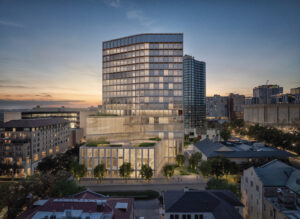
FOLLOW MULVA HALL
Keep up with the latest fundraising and construction updates, read the history of McCombs and our century of innovative educational centers, and learn more about how you can contribute.
About this Post
Share:
